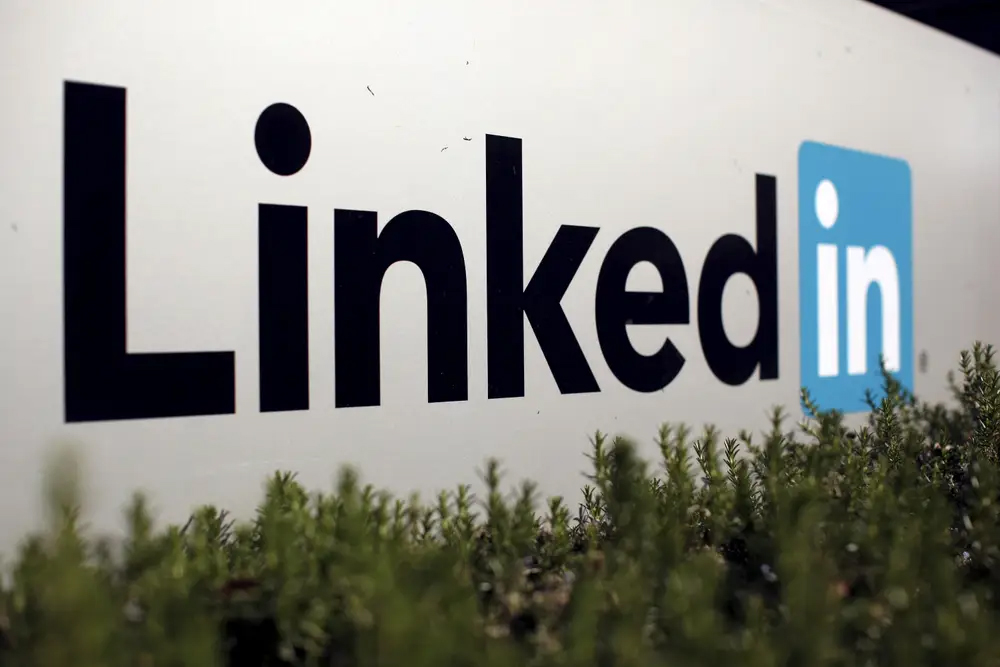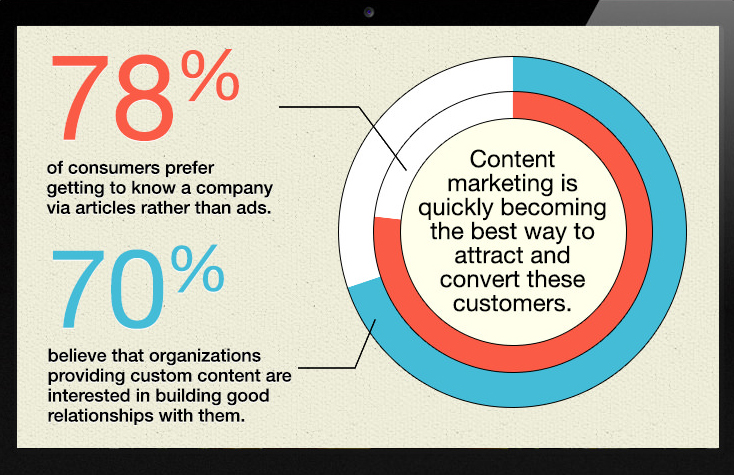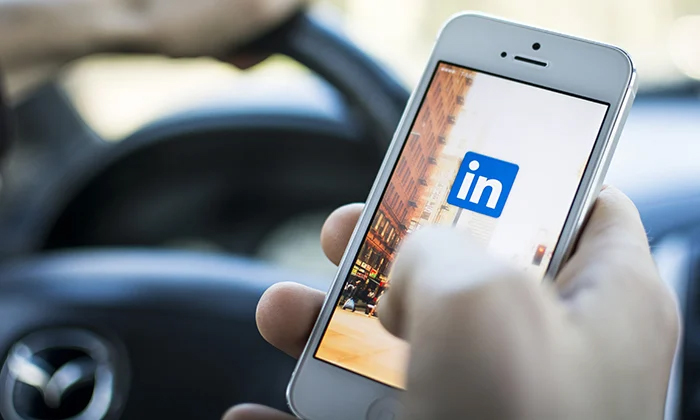YouTube can be an effective video platform for small business marketing. Here’s how to use it to its full potential.
- YouTube is home to more than 2 billion users worldwide and drives more than 30 million daily visits, making it a great platform for small businesses looking to market with video content.
- Video is extremely engaging and useful for many types of businesses. Creating a YouTube channel for your business offers a centralized platform for your audience to view and engage with your videos.
- Completely fill out your YouTube profile and follow these tips to upload engaging video content that will resonate with your audience and grow your followership.
- This article is for small businesses looking to improve their marketing strategy by adding video content and boosting engagement with their audience.
Since its launch in 2005, YouTube has become a modern media powerhouse. Currently, YouTube has more than 2 billion users worldwide and 30 million daily visitors. Nearly 500 hours of video are uploaded to the site every minute, with more than 2,400 channels that exceed 1 million subscribers. The platform was purchased by Google in 2016 and currently ranks No. 2 for global and domestic web traffic, according to Alexa.
Marketing is moving toward video over static content, and YouTube is a key player. For an individual user, the site appears straightforward, but it’s more complicated if you want to use it to market and grow your business. Here’s what you should know to use YouTube for business.
How to set up a YouTube channel
These guides break down the process by which you can set up a YouTube channel for your small business. Each examines an important element of creating and optimizing your YouTube channel.
- Signing up for a business YouTube account
- Customizing your YouTube profile
- Interacting with others on YouTube
- Verifying your channel
- YouTube Live
- Trending videos on YouTube
- YouTubers and influencers
- Advertising on YouTube
- YouTube Partner Program
- YouTube Premium
- YouTube tips and tricks
Signing up for a business YouTube account
Most social media networks require you to set up an account before you can view content. That’s not the case with YouTube; you can view content without a YouTube account. However, an account is required for your company to upload videos and engage with other users. Membership is also required to view videos flagged as adult content.
Follow these steps to create your business YouTube account:
- Sign in to your company’s Google account. If you use Gmail for your business email, you’ll use the same username and password for your YouTube account that you use for Gmail. Alternatively, you can create a new Google account that you use solely for YouTube business purposes.
- Once signed in, visit YouTube’s homepage. Double-check that you’re signed in to the appropriate business account instead of your personal YouTube account.
- Click on your Google account’s avatar. You’ll find this in the top right corner. It’s a small circle containing your picture (or your company’s logo if you’ve set that as your email address’s picture).
- Click on “Your channel.” This option will appear in the dropdown menu that displays when you click your avatar. It’s the top option in the first batch of icons.
- Choose “use a business or other name.” You’ll need to select this option to get started with a business YouTube account. You can then enter your company’s name.
- Click “Create.” Then, voila! You have a business YouTube account.
Once you’ve taken these steps, return to the YouTube homepage. In the top left corner of the page, there is a dropdown menu with quite a few options. There are links for the homepage, trending videos, your library and your subscriptions. Your library lets you organize which videos you’ve watched, liked and saved for later. Under your subscriptions, you can see all the channels you’re subscribed to and receive notifications when they’ve uploaded new content.
In the top right corner of the page, there are four buttons. The one closest to the center, which is an icon of a video camera, directs you to the page where you upload a video. The middle icon, a square comprising nine smaller squares, is for YouTube apps. The next one, the bubble icon, will take you to messages. The next button is an icon of a bell, and it notifies you of your account activity, such as a new like or comment. The one closest to the right side, which is an icon of your profile picture, will direct you to your account information pulled from Google.
Key takeaway: You can create a YouTube channel for your business to begin uploading video content that your audience can view, like, comment on and subscribe to.
Customizing your YouTube profile
Once you’ve signed up for YouTube, you’ll need to customize your profile with your business’s information. Every user is assigned a channel according to their username, and you’ll be given a specific URL so other people can find your channel through a direct link – but you’ll need to do more than the basics to stand out from the competition.
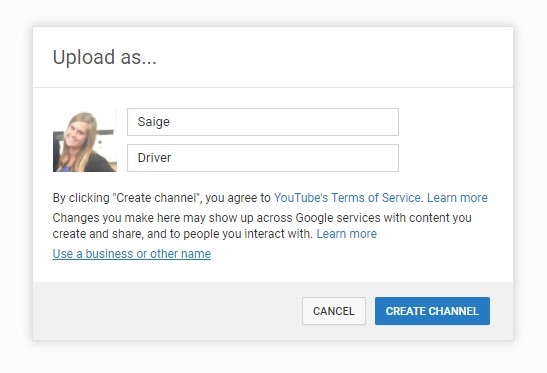
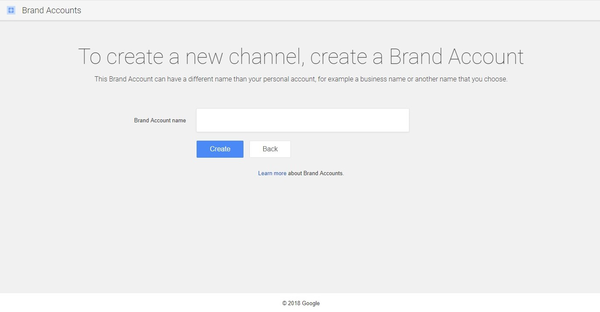
Take these steps to customize your channel:
1. Add channel art.
YouTube channel art is similar to a Facebook or Twitter banner. This header is a great place to add your business’s logo and tagline.
Your profile photo (also known as a channel icon) and channel art should represent your brand clearly through high-quality photos. If you don’t upload a photo or art, YouTube will fill in generic images for both. However, your profile photo is pulled directly from your Google account and must be uploaded through Google, not YouTube. It will take a few minutes to sync your Google profile photo to your YouTube account.
These are the ideal dimensions for YouTube channel art files:
- Channel icon: 800 x 800 pixels (displays as 98 x 98)
- Channel banner: 2560 x 1440 pixels, though for mobile and web use, the “safe” dimensions are 1546 x 423 pixels.
Given the large size of these files, it’s important to use high-resolution images (ideally 300 dpi) for your channel icon and banner. You’ll best understand whether your channel icon and banner will look good on your page if you spend ample time toying with YouTube’s preview and cropping tools. Don’t be afraid to use this tool several times to perfect your images. If your page looks subpar, visitors will be less likely to stick around and explore your content.
2. Fill in your business info.
It’s important to share information about your business, its services and so on. You can do this in the About section of your YouTube account while adding your website as well as your company’s tagline.
Start with your About section’s channel description. Keep it short and sweet: You just need a concise mission statement with at most three links and a minor call to action. Then, scroll down to the “email for business inquiries” box and put the appropriate email address there.
Finally, you’ll encounter the Links section. There, you can add whatever links you want: your business website, your other social media pages and any other webpages to which you want to direct your viewers. You can include as many as five links and up to 30 characters of customized hyperlink text for each. The more links you have, the higher your chances of driving traffic to your business website and engaging your YouTube viewers.
As you write the copy for your channel description and links, you should use keywords to increase your visibility in YouTube searches. We’ll discuss that in more depth later.
3. Create a channel trailer.
While optional, a channel trailer – a brief video that introduces viewers to the content they’ll find on your YouTube channel – is an excellent customization option to increase YouTube viewer engagement. Once you add this trailer, it will appear on your account’s homepage when viewers visit, helping to reel them in and acquaint them with your brand.
Key takeaway: You should completely fill out and customize your YouTube channel to stand out on the platform.
Interacting with others on YouTube
There are several ways to interact with other YouTube users.
- Comments: Comments can be organized by most popular or newest. You can boost your video’s engagement traffic by responding to users who comment on your videos.
- Likes: This is a more passive form of interacting with content. However, if you’ve chosen to show your likes publicly on your channel, these videos will appear under the playlists section on your channel.
- Subscriptions: The best way for users to stay up to date with your brand’s content is to subscribe. Every time you upload a new video, your subscribers receive a push notification. You should constantly encourage viewers to subscribe to your channel, as it improves your engagement traffic and increases the number of views. Many popular YouTubers incorporate reminders to subscribe at the beginning and/or end of their videos.
- Playlists: You can organize related content together using the site’s playlist feature. If you choose to publicize your playlists, they will appear on your channel’s page below your uploaded content. You can also organize other users’ content with a playlist. For instance, if you run a marketing agency, you could compile a client’s videos into one big list. Otherwise, this is another way to organize your own content on your channel.
- Sharing: The site’s social widget allows users to share videos on other social media networks, such as Twitter, Facebook, Google Plus, Blogger, Reddit, Tumblr, Pinterest and LinkedIn.
- Messages:You can also share private videos and messages with friends and contacts on YouTube.
Key takeaway: Engagement begets engagement, so stay active and interact with others on the platform to drive engagement with your own audience.
Verifying your YouTube channel
How will you know if a channel is verified or not? There will be a small checkbox, which indicates a verification badge next to the channel’s name. To apply for verification, your channel must have 100,000 subscribers. However, interested businesses can contact Google directly to inquire about verification.
YouTube Live
Similar to Facebook Live, YouTube has its own livestreaming feature. Broadcasts are usually oriented around news or sports. YouTube Live isn’t as important as the site’s standard video format, because it’s not as widely known, and your account must be verified to conduct a livestream.
If you choose to do a livestream, there are four ways to go about it. The first, which is the quickest, is the Stream Now option. The second is through the Events tab, which gives you more control, because you can preview your stream ahead of time. The third option is found on the site’s mobile app; if you use this, the stream will later be archived on your channel. Lastly, you can stream from your computer’s webcam.
Trending videos on YouTube
Trending videos are videos that YouTube users are interacting with at very high rates. Often, these videos were uploaded within the last couple days. You can view the current trending videos under the Trending tab on the YouTube homepage even if you’re not logged in or don’t have an account.
Trends reflect popular culture, one-off viral hits and current events. The site also features users tagged with a blue Creator on the Rise, Gaming Creator on the Rise, or Artist on the Rise badge next to their channel names on the Trending Videos page. These channels are showcased for 24 hours. To make the cut, your channel must have more than 1,000 subscribers, and users can only be chosen once.
For brands, the goal of creating trending content isn’t necessary. It could be a shoot-for-the-stars goal, because if one of your videos goes viral, it could end up on the trending page and thus create significant exposure for your company. However, silly commercials, like those on the Super Bowl, have trended on YouTube shortly following their television debut, and you might not want your videos to have that kind of tone. It’s perfectly fine, even wise, to focus on appealing to your niche audience instead.
Key takeaway: Trending videos on YouTube are the videos currently getting the most engagement. Going viral is a nice goal but not necessarily the ultimate marker of success, depending on your channel’s audience and tone.
YouTubers and influencers
You might have heard about YouTubers, or video content creators solely based on YouTube. These are essentially personalities, such as those on television talk shows or reality shows, with their own unique channels.
Many specialize in a particular niche, like cooking or beauty, while others document their day-to-day lives in the form of a vlog. Many of these personalities have grown and maintained a large following, sometimes with hundreds of thousands or even millions of subscribers, such as Grace Helbig and Tyler Oakley.
While recruiting such a large following is an admirable goal for small businesses, that isn’t the only thing we can learn from YouTubers. In fact, working with YouTube personalities can be a smart business move. [Learn more about working with influencers.]
Many YouTubers have corporate sponsorships. These sponsors send YouTubers their products to mention or use in their videos. Often, YouTubers will verbally mention the sponsor company and how awesome its product is. For instance, makeup companies often send popular beauty vloggers their products so they can make videos applying the makeup. Some creators upload haul videos where they review several products at once.
If your business has a service or physical product that fits a certain YouTuber’s niche, it’s worth reaching out to see what their rates are and if they’d be willing to feature you in a video.
Key takeaway: Connecting with influencers to establish partnership deals can elevate your brand on YouTube, helping you reach more viewers and legitimizing your channel.
Advertising on YouTube
There are a few ways to advertise on YouTube, as users reap the benefits of the site’s free service. Since the site is based on video content, companies are encouraged to add a call-to-action link directing viewers to their website following the video.
There are four video ad options, including TrueView in-stream ads, which play before, during or after other videos. After five seconds, users can skip the ad. You’ll only be charged for the ad when a viewer watches 30 seconds of the ad or interacts with it in some way.
There are also discovery ads, which appear when a user is searching or browsing content on YouTube or across the web. These clips aren’t limited to 30 seconds; they can be as short or long as you wish. You’ll be charged every time someone clicks on the ad to watch the full video.
Bumper ads are six seconds or less, and users can’t skip these. These ads also appear before, during or after another video. Outstream ads play only on mobile devices, showing up on partner websites and within apps. You’ll be charged for these ads based on cost per thousand impressions, or vCPM.
Key takeaway: Paid advertisements on YouTube can help you monetize your video content by giving your audience an easy way to buy your products and services.
TrueView for Action
TrueView for Action allows you to drive leads and conversions by adding a prominent call to action and headline text overlays to a TrueView in-stream ad. You will need to set up conversion tracking to run the campaign.
YouTube also has a curated directory of ad agencies that can be matched to your business needs and is planning to create video-creation tools to help users more easily create ad content.
YouTube Partner Program
You can monetize your content with the YouTube Partner Program. You earn money from advertisements on your videos and when YouTube Premium subscribers watch your videos. You’re eligible for the program once your channel reaches 4,000 watch hours in the previous 12 months and 1,000 subscribers.
You can check your watch time and subscribers under YouTube Analytics on your dashboard. While it may be difficult to reach these requirements, the program allows you to make money on videos you plan to create anyway.
YouTube Premium
YouTube Premium (formerly YouTube Red) is a subscription service, starting at $11.99 a month, that allows users to stream video content and music without advertisements at the beginning of videos. It also lets you download videos to watch offline.
Although you don’t need a premium subscription to operate YouTube for your business, it’s good to know the latest news about the site to familiarize yourself with it. Also remember that videos are ad-free with this subscription. At the end of the day, though, YouTube Premium could hurt your business, because the premium services take users away from in-stream advertisements.
YouTube tips and tricks
Now that you understand how to use YouTube, here are a few tips to use the site to your brand’s advantage.
1. Encourage viewers to subscribe.
Subscribing is the best way for your audience to know whenever you’ve uploaded a video, created a new playlist and more. It also gives you an estimated figure as to how many people will eventually view your video.
2. Share videos on other social media platforms.
Link back to your videos whenever possible on your website and other social media networks. Don’t stop at direct video links, though. Link back to your channel so your audience can see what it looks like and have the chance to subscribe.
“[You should] have a video strategy,” said Tracy Sestili, head of marketing at SparkPost. “Without a strategy, you can post videos as a repository, but you may not get the return.”
3. Use relevant keywords in a video’s title, tags and description.
Experiment with different titles and descriptions. Selecting relevant keywords to increase hits is a common SEO strategy for marketers on any social networking site. It helps audiences find content that interests them. A quick exercise would be to watch one of your company’s videos from the beginning and then create a list of relevant words and phrases as you watch. You should also be realistic about which keywords you use, though.
“Don’t go after keywords that big brands compete for,” said James Robinson, marketing advisor at Iconic Genius. “Go after local keywords.”
4. Engage with similar content uploaded by other users.
Like and comment on videos uploaded by other users. Not only might those users stumble upon your videos and channel, but anyone else who sees that comment or like might as well. Do this with videos that have a similar topic, interest or theme as yours to attract new viewers.
5. Display content uploaded by other users.
In addition to liking and commenting on other users’ videos, you can highlight featured channels and your liked videos on your own account. In doing so, you show that you’re active in your industry’s YouTube community and direct traffic – a much-needed internet commodity – to other YouTube users in your realm. Be sure to highlight videos that are relevant to your viewer base and not uploads from your direct competitors.
6. Curate playlists.
If any of your videos follow a consistent theme, organize them together. Perhaps you upload a video every Friday morning; you could compile all those videos into a “Friday series” playlist. Your playlists will appear on your channel’s page, right below your uploaded videos.
7. Upload content regularly.
Especially if you’ve developed a decent pool of subscribers, viewers will be counting on you to create, edit and upload new content. This adds relevance to your brand. This also applies to any other website where users can follow and engage with your content.
“Be consistent,” said empowerment coach Michelle Baxo. “I found that I was building the most traction when I did a weekly post at the same time and notified [subscribers on] my social networks.”
8. Use clickable links to reference other content.
At the end of videos, you’ll notice many videos reference previous, relevant or even newer content with a clickable link inside the video. You can add these while editing your video in the site’s video manager. This feature can also link to any pages or sites your video covers.
9. Work with top content creators to place products.
Popular YouTubers, especially those with frequently trending content, have hundreds of thousands to millions of subscribers constantly watching their channel. It could be a great business opportunity to reach out to them as a potential sponsor. Many YouTube personalities place products in their videos, which gives a specific brand a larger audience than usual.
10. Use YouTube stories.
YouTube recently created YouTube stories, which are similar to Snapchat or Instagram stories. A story is a collection of short videos that can remain visible for a day or until they’re deleted. Google is now testing Al to swap backgrounds in stories, running a beta version of it with some content creators.
11. Run a contest.
Running or promoting a contest on YouTube is an easy way to get people to watch and engage with your content. However, before you post a contest, read YouTube’s rules and guidelines.
Key takeaway: You can follow certain best practices to boost your video content on YouTube and improve your relationship with your audience.
Adryan Corcione and Saige Driver contributed to the reporting and writing in this article. Some source interviews were conducted for a previous version of this article.
Source: https://www.businessnewsdaily.com/9854-youtube-for-business.html

